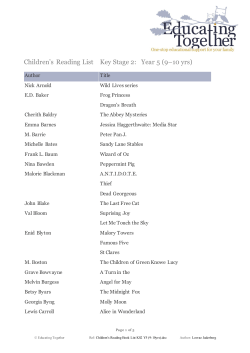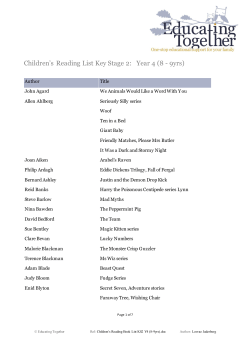
TTU UD DO OR
1240#05_VOX06_096_110
18-01-2006
13:30
Pagina 100
TUDOR
The “Other”
Rolex Br and
By Julien Schaerer
any collectors are
unfamiliar with or
know little about the up
and coming Tudor
brand. The name “Tudor” was first registered in Geneva by
Isaac Blumenthal on
December 13, 1906
under registration number 21383. It was then
transferred to Philippe
Huther de Colombiere
Julien Schaerer
in 1926, and finally
Director
sold to Hans Wilsdorf
Watch Expert
in 1936. No one has
precise records, but the first traces of the Rolexproduced Tudors appear in the mid-forties, after
the Second World War. Despite the generally
prevailing public opinion, there is actually very little difference between the design and conception
of Tudor and Rolex. Apart from Tudor watch
movements generally having fewer jewels, their
conception and construction were virtually identical to those of Rolex. Rolex felt strongly that in
producing a “second line” of watches, the public
perception of Tudor had to be equivalent to that of
Rolex. As such, they even extended the Rolex warranty to all Tudors at the time. All early Tudors,
until the mid-1990's, featured Rolex crowns and
cases. Rolex bracelets were used until 1971 when
the first Tudor signed bracelets appeared on
women’s watches.
M
The differences in caliber used in Rolex and Tudor
watches will be addressed in a future article; here
we will focus on some of the more collectible
models.
-{100}-
Ref. 7928
1240#05_VOX06_096_110
18-01-2006
13:30
Pagina 101
Tudor Prince Submariner
Ref 7922 and 7924: the “non crown-guard”
Submariners. As with Rolex Submariners, this
model (Ref. 7922), water resistant to 330ft., came
with a small crown and thicker case. Ref. 7924
had a larger case and crown to support the
increased water pressure (to 660ft) . Both these
models first appeared in 1958 and were fitted with
the famous caliber 390, a 17 jewel movement
based on the Valjoux 722. It is interesting to note
that the Tudor Submariners have always been selfwinding, unlike the earlier Rolex Submariners.
Ref 7928: At approximately the same time, the
second series of Submariners was launched with
crown-guards, Reference 7928 (SFr 360). This
Submariner, water-resistant to 660 ft, was the
equivalent of the Rolex Submariner Ref. 5513, so
close that it even used its bezel. This watch still
used the same caliber, 390, and was produced
until 1966.
Ref 7016 and 7021: in the 1969-1970 Tudor catalogues two new references appeared. Ref. 7016
was considered the successor of 7928 but some
significant changes were noticeable. Firstly, a new
caliber was introduced, caliber 2461. This 11 1/2'’‘
ligne movement now had 25 jewels and was ETAbased. Secondly, the dials changed (available in
either black or blue) and for the first time bore the
square military-type indexes. The second model,
reference 7021, was identical to the first, with the
exception of the date with cyclops lens. The movement, caliber 2484, was also ETA-based, with 17
jewels.
Ref. 7924
Ref 9411: 1973 saw the launch of the last
Submariner reference, 9411. It replaced Reference
7021 and was identical to it, with the exception of
the movement, which was replaced by caliber
2784, with 25 jewels.
There are a few other Tudor Submariner references, however it is the earlier ones which are of
most interest to collectors.
It is also important to note that Tudor was a major
supplier of specialized divers’ watches for many
armed forces, most notably the French Marine
Nationale (M.N.) and the US Navy. These watches
were supplied as early as the 1960s, with
Reference 7928, and continued through the mid
eighties.
Ref. 7016
Ref. 9411
-{101}-
1240#05_VOX06_096_110
18-01-2006
13:30
Pagina 102
Ref. 7169
Tudor Chr onogr aphs
The Tudor chronographs are probably the most
collectible Tudors on today’s market. They can be
divided into three distinct generations.
Chronographs appeared in the Tudor catalogues
for the first time in 1971, but strangely the first
generation was never illustrated.
Ref. 9420
First Generation: Ref. 7031 and Ref. 7032. These
chronographs were only produced for two years, in
1970 and 1971. They both featured the manuallywound caliber 7734 and the only difference
between them is that reference 7031 has a black
plastic bezel and 7032 a fixed metal tachometer
bezel. Their most distinctive features are the characteristically shaped indexes and the colorful
orange markers of the dial.
Second Generation: When Tudor first introduced
a revolving blue metal bezel (Ref. 7169) in 1971,
the chronographs still featured the characteristic
markers on all three references (Ref. 7149 and
Ref. 7159). The evolution from the first to second
generation was marked by a new chronograph
caliber, 234. It is also important to note that while
in their official catalogues this is the only type of
dial offered, in advertisements, the new dials can
be seen. These featured a new type of luminous
straight marker, as well as new dial colors, including a blue surround and blue sub-counters.
Third generation: Tudor chronographs became
self-winding. They were introduced in 1976 with
new references, indicating a different bezel from
all previous generations. All three references are
fitted with the famous caliber 7750 and now feature two chronograph counters, a subsidiary dial
for constant seconds and the date at 3 o’clock.
The 9420 now features a plastic tachometer bezel,
the 9421 a revolving black (or blue) bezel and the
9430 a fixed metal tachometer bezel. The first of
these chronographs only bear the inscription
“Chrono-Time” while the later models bear the
words “Oysterdate Automatic Chrono-Time”
around the counter at 6 o’clock. These chronographs were to evolve over the years (the dials
were offered in various colors and configurations)
with different reference numbers up to 94300. All
had the same characteristics, and in the late
1980’s Tudor stopped producing the so-called exotic dials.
-{102}-
Ref. 9421
Ref. 94300
1240#05_VOX06_096_110
18-01-2006
13:30
Pagina 103
Tudor Advisor
This was another interesting development from
Tudor/Rolex, a wristwatch with alarm. The Advisor
appeared in 1957 and was offered as three different references until it was discontinued in 1977.
Ref 7926: in a traditional mid-sized Rolex case
with a riveted Rolex bracelet. Equipped with
manual winding 17 jewel caliber 1475, it was
offered with at least three different dial configurations, with either faceted or diamond indexes,
or Arabic numerals. Dials were available in either
silver or black.
Ref. 7426
Ref 1537: the dressier version of the Advisor with
a thinner case and lugs. Both Ref. 7926 and 1537
were available until 1968.
Ref 10050: the last and final version of the
Advisor, available from 1969 to 1977. It was in
stainless steel only (SFr 270), and was fitted with a
new movement, caliber 3475.
Ref. 7926
-{103}-
1240#05_VOX06_096_110
18-01-2006
13:30
Pagina 104
Tudor Da y-Date
Also one of the most attractive Tudor watches due to
its oversized steel case and its resemblance to the
Rolex Day-Date. A particularly desirable version is the
one with an oversized rotating bezel. The Day-Date
came in three distinct models, each with its own distinct bezel. The watch was also available with a
variety of dials, in black, gray, silver, or blue. The
model evolved throughout the years. Here we will
focus on the earlier models which appeared in Tudor
catalogues from 1970 to 1979, at which point the
reference was changed to 9450 (9451 and 9461).
These references, 7017, 7019/3, and 7020, were
equipped with a non quick-set 13 3/4 line
movement, caliber 1895.
Ref 7017: the classic day-date with a
fixed bezel, available only in steel with
either a leather strap or a metal bracelet
(SFr 398 and 430).
Ref. 9450
Ref 7019/3: with fluted bezel, available in stainless steel and yellow
gold or stainless steel and white
gold (ref. 7019/4) (SFr 498 and
520 respectively).
Ref 7020: the most collectible of
all three models, with a rotating
steel bezel. Truly distinctive, it
has no equivalent in the
Rolex range (SFr 440 with
leather strap).
Ref. 7017
Ref. 7020
As Rolex prices constantly increase, the Tudor range
offers good entry level watches that may be collected
at reasonable prices, and which, in addition, utilize
many Rolex parts. And remember, when buying a
vintage Tudor, look for models that reflect their age
and are as original as possible. Spare parts are scarce,
so keep this in mind when buying a Tudor that
requires repair.
-{104}-
© Copyright 2025













